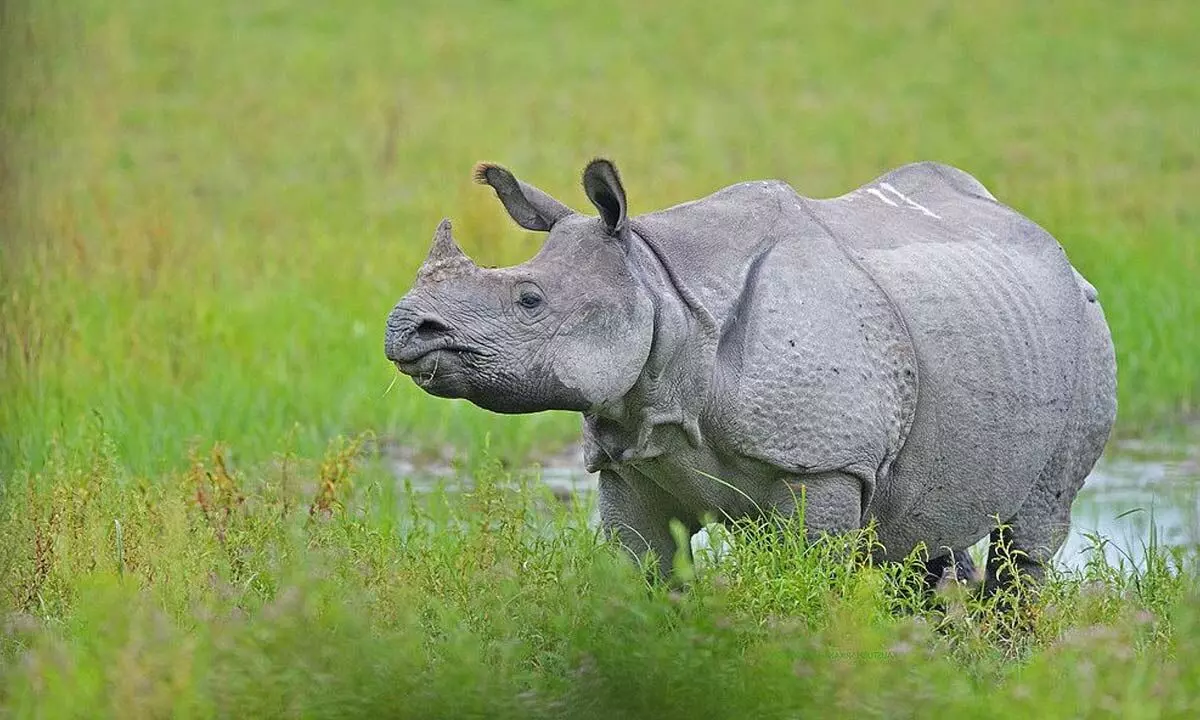Saving India’s wild ‘unicorns’

India’s alarmingly low greater one-horned rhino population prompted the government to announce a conservation programme, Indian Rhino Vision-2020 in 2005
India’s alarmingly low greater one-horned rhino population prompted the government to announce a conservation programme, Indian Rhino Vision-2020 in 2005. Twenty-two sub-adult rhinos were translocated from Kaziranga National Park and Pobitora Wildlife Sanctuary to Manas National Park from 2008 to revive the population there.
By the early 2000s, the rhino population in Assam was decimated, primarily by poaching. In an attempt to reverse this situation, the state government and Bodoland Territorial Council, with support from the International Rhino Foundation (IRF), World Wide Fund for Nature (WWF) and the United States Fish and Wildlife Service (USFWS), launched a programme, the Indian Rhino Vision 2020 (IRV-2020), in 2005. The target was to take the population to 3000 rhinos by 2020 through increased protection of the existing population in Assam and relocating rhinos to protected areas (PAs) which they previously inhabited. Manas national park bordering Bhutan was one such protected area where a total of 22 rhinos — 10 from Kaziranga national park and 12 from Pobitora wildlife sanctuary — were translocated.
A recent study by WWF India looks into the outcome of the translocation effort and the status and behaviour of the translocated rhinos.
Since 1928, when Manas national park, a UNESCO world heritage site, was declared a sanctuary, the park and its inhabitants have witnessed various changes and upheavals. In 1990, it was designated as a national park, covering an area of 360 km2. In 2016, an additional 350 km2 of the Manas Reserve Forest was incorporated into the park for rhino range expansion. Historically, rhinos were hunted for trophies and later poached for their horns. Socio-political unrest between indigenous people and other communities, as well as army operations to contain the clashes, kept the region in perpetual strife. All these factors led to the local extermination of Manas’ rhinos, which were believed to number around 100 prior to these events.
With its alluvial grasslands, semi-evergreen forest and moist and dry deciduous forests, as well as elevation ranging approximately between 50 and 250 metres above mean sea level (AMSL), with the Manas-Beki river system providing a constant source of water, Manas national park is considered an ideal rhino habitat.
Senior manager of a Guwahati-based NGO Aaranyak, Deba Kumar Dutta who was earlier with WWF India and was part of IRV-2020, says that the translocation was a success. It not only bolstered rhino numbers in Manas but also contributed to the development of the national park through initiatives such as establishing anti-poaching camps, infrastructure development and habitat protection. He highlights the improvement in the relationship between local communities with the park as well as the rhinos. “An institutional approach was adopted for the translocation. Before the project, there were no facilities inside the park and even forest guards were hesitant to enter. However, things changed drastically after the initiation of this project,” he shares. The global population of the greater one-horned rhino (Rhinoceros unicornis) in the family Rhinocerotidae stands at 4,023 (June 2022), of which 81.3% or 3,271 individuals reside in India’s national parks and wildlife sanctuaries.
The CEO of Aaranyak, Bibhab Kumar Talukdar who is the senior advisor of International Rhino Foundation for Asian rhinos and the chair of Asian Rhino Specialist Group of IUCN SSC says he believes that translocation was the best option for Manas since it is far from other rhino-bearing areas in Assam. “The natural dispersal of rhinos from other areas is not possible in Manas due to lack of connectivity and human settlements,” he says, adding that moving rhinos from Pobitora and Kaziranga was ideal.
According to Talukdar, the contiguous protected areas of Laokhwa and Burhachapori wildlife sanctuaries west of Kaziranga national park which lost all its rhinos during the socio-political unrest in the 1980s too are considered for rhino translocation under IRV-2020. Interestingly, however, the Assam government’s decision to add additional lands to Kaziranga, Burhachapori and Orang national park in the past few years along the river Brahmaputra, resulted in the protected areas getting reconnected, facilitating rhino movement between them.
Constant monitoring
yields result
The study notes many positive outcomes of the project after monitoring 10 translocated rhinos through radio collaring over a five-year period from 2008 to 2013, starting with the first two rhinos R1 and R2 and gradually increasing the number of rhinos observed. Thirty-eight calves were born to translocated rhinos between 2011 and 2021. Dutta says that most behaviours observed were similar to rhinos in the wild.
The paper highlights distinct seasonal variations in activities, largely influenced by the availability of food and water. While maximum grazing activity was observed during the monsoon and retreating-monsoon seasons, rhinos were found to graze less during the winter season. Researchers attribute this mainly to the higher elevation and abundance of edible grass in Manas compared to flood-prone areas like Kaziranga and Pobitora. It also reports frequent courtship and mating among the rhinos, resulting in 38 calves, bringing the current population at Manas to 50.
Wild-to-wild
translocation
The paper recommends several crucial steps to ensure the future survival and well-being of the newly established rhino population at Manas, including the implementation of genetic management plans to maintain genetic diversity and prevent inbreeding; sustainable habitat management practices to restore preferred rhino habitats; and the establishment of a robust disease surveillance system to guard against potential health threats.
(https://india.mongabay.com)















